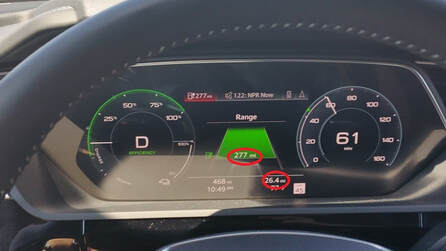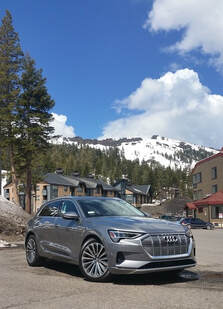 303 miles with an Audi etron?
303 miles with an Audi etron? In this blog, I'll be doing quite a few comparisons to our Chevy Bolt. These are not intended to be comparisons of the vehicles themselves, but of the performance and range with respect to their EPA ratings on routes we've traveled literally dozens of times.
Our story begins with my previous post comparing the Audi etron to the Jaguar I-Pace. After reading it, the GM of Audi Steven's Creek in San Jose, asked Cassandra Crawford, his head of fleet and internet sales, to offer us an etron for a more extensive test drive. We picked up the etron on Friday afternoon, drove to our place in the Sierra Nevada, put it through its paces in the mountains, and returned the car on Monday afternoon.
Before I get into range discussion, let me just say that this is the quietest car we've ever driven and is a joy to drive.
Why is EV Range Important?
For experienced EV drivers, range is important for the following reasons:
1) We need to do our regular commutes without having to stop to charge.
2) On long trips, we don't want to have to spend hours waiting to charge.
We recognize that for most EVs, highway range is much worse than city range. For our Bolt, rated at 238 combined miles per the EPA, we see nearly 300 miles of range around town, but only about 210 miles on the highway at 65-75 mph, substantially less with a headwind.
When we heard about the 204-mile range, we cancelled our order for an etron. What kind of range would we get on the highway? And what about our trips to the mountains, our primary motivation for an AWD SUV? We 'commute' to our place in the mountains a few times a month and at least weekly during ski season. It's 175 miles with nearly a 4000' altitude gain. Our Bolt makes it with between 15% and 20% of the battery left and an average miles/kWh of about 3.5: an effective range of 210 miles.
If the Bolt loses roughly 12 percent of its EPA range on this trip, and the etron lost 12% of it's 204 miles, it would be far too close in the etron, right?
A Note about Driving Style and Regen
Whether in a gas-powered car or an EV, we all drive differently depending on the conditions and our motivation for being on the road. In a hurry or want to race? You probably don't care too much about your gas mileage or EV range. Want to reduce costs and stops? You probably drive more efficiently.
There has been a lot of debate about driving an EV with max regen. Many drivers argue that the excessive regen braking is not as efficient because you're always having to make up for slowing by accelerating. Others say that coasting is better. But the bottom line is that per the Bolt EV forum (and the Bolt has the strongest regen of any EV we've seen with true single pedal driving), at least 90% of Bolt drivers agree that they get their best range in L mode (max regen) - all the time.
While this may sound counter-intuitive. The fact is that once you're experienced with max regen, you use your accelerator pedal efficiently. You can slow the vehicle, let it coast, or accelerate just by applying the right amount of pressure. It may sound complicated, but it's not. It becomes second nature after you've driven a bit.
So, although Audi claims that their 'Automatic' mode will determine the most effective regen by coasting at the right time, I have my doubts. We didn't get to test that feature and there is a lot of magic in the etron, so it's possible, but I wanted to compare apples to apples, so we drove the etron in Efficiency mode with max regen all the time.
For those of you concerned about 'Efficiency mode', don't be. As we've seen with most EVs, there's more than enough power to spare. EVs accelerate onto the freeway effortlessly and pass on two-lane roads pinning the passengers to the seats - even in 'efficiency' mode.
The Range Numbers on the Trip
 Audi etron at Kirkwood (7800')
Audi etron at Kirkwood (7800') We left the Audi dealer about noon. Temps were in the mid 80s, upper 80s across the Central Valley and we hit thunderstorms in the mountains. With the very warm temperatures, air conditioning was a must.
The first thing we noticed, which worried us quite a bit, was that our efficiency on the surface streets getting to the freeway, on the Mission Street connector to 680, and in traffic jams was much lower than we expected, right about 2.2 miles/kWh. At that rate, with a 4000' altitude gain on this trip, even the 140 miles might be tight.
The weird thing was that we seemed to get better range on the freeway at 70-75 mph. We finished the trip of 140 miles with an average of 2.5 mi/kWh, 56 miles on the guessometer, and 32% of the battery left. This works out to roughly 205 miles of range. Remember, our Bolt has an effective range on this trip of 210 miles. Not too bad!
Saturday, Karen took the wheel and we traveled down to Valley Springs (mostly 55 mph speed limit) for a round of disc golf, and visited Volcano on our way back up. Karen had a difficult time keeping the etron anywhere near the speed limit and loved the smoothness, silence, and handling. We covered 86 miles and had 62% of the battery left, effectively 226 miles.
Sunday, we drove up to Kirkwood on highway 88. It's 39 miles and we have to cross Carson Pass at 7990 feet. The net altitude gain to Kirkwood is 4500 feet. Speed limit is 55 and you can comfortably drive 60 except for a couple of miles over Carson Spur. The etron averaged 1.7 miles/kWh. I note that the Bolt only averages 2.2 miles/kWh on this stretch.
Returning, the etron only used 3% of the battery for the 39 miles, and averaged 2.8 miles/kWh for the 78 mile round trip with 77% of the battery remaining. For the Bolt, we average 4.0 mile/kWh on this stretch or 240 miles - very close to the EPA 238. The etron's range on this trip works out to 234 miles.
We headed home late Monday morning. The picture of the console at the top of this post was taken as we hit the flats 26 miles into our trip. Much of that 26 miles was downhill and you can see that the total range - guessomenter + miles driver - was 303 miles. Of course the next 117 miles, mostly at 70-75 mph reduced that a bit, and we arrived at the dealer after 143 miles (we stayed on 680 to 280) with 116 miles on the guessometer (a 259 mile range). We averaged 2.8 miles per kWh. On this same stretch, the Bolt averages 4.2 miles per kWh or about 5% beyond its EPA rating. So multiplying the 2.8 miles/kWh times the 83.6 kWh available in the etron and reducing it by 5%, we have a range of 222 miles - almost all of it highway.
Conclusions
We scratched our heads about how the EPA rating could be so wrong. With 85-90 degree temperatures, we had climate on (except for the trip to Kirkwood where it was cool). We drove mostly highway speeds which is generally a worst case scenario for an EV. And yet, our best guess for the etron highway range is over 220 miles.
We looked at the Monroney Sticker (the sales sticker) and got one clue. According to the EPA, the miles per gallon equivalent (MPGe) for the highway is 73 and for the city, it's 74 with a combined rating of 74. Every other EV has a dramatic difference between the City and Highway EPA ratings. For example, the Bolt has 128 City and only 110 Highway.
This means that unlike most EVs, the etron gets almost the same range on the highway as around town. What would you say to an EPA rating of over 200 miles highway?
We suspect that the highway/city thing is due to the weight of the etron. At over 5600 pounds, it takes a lot of energy to get it moving (hence the low City figure). On the other hand, once moving, and especially downhill, the momentum and reasonably low coefficient of drag, improve its Highway numbers. The weight probably explains the remarkable numbers for our downhill stretch from Kirkwood - a lot of regen!
We also suspect that the EPA tests were done in 'Automatic' mode. Perhaps our driving in 'Efficiency' mode with max regen made the difference.
In any case, for our purposes, the Audi etron has a combined (actually highway) range of over 220 miles. It's extremely efficient downhill - probably more so than the Bolt, and doesn't seem to lose much range at 75+ mph. Combine that with the fact that the etron charges faster than any car currently on the market, and it also makes sense for longer trips. Plus, as I mentioned, Karen and I find this to be the nicest car we've ever driven.
Originally, our plan was to replace our Audi Allroad with an EV SUV to get us to the snow in the winter. Our Bolt is our primary vehicle and the Audi is really just for the snow. But this car is such a pleasure to drive, we'll probably take it on all road trips.
One Last Note
The etron we drove was a Prestige with 21-inch wheels. The one we ordered will have 19-inch wheels. From what I've read, the smaller wheel size should increase the etron's range by 5%-15%. That would put it within reach of our Bolt - not bad for a true luxury SUV.
If you've been afraid of the etron because of the EPA rating, don't be. I think you'll be more than impressed with its range in real driving conditions!
Check out my next blog on the etron: Our Remarkable Audi Ski-tron.
And, if you liked this blog, please check out my novels.


 RSS Feed
RSS Feed